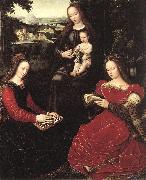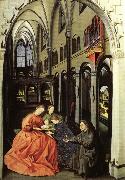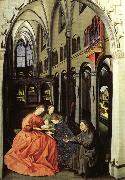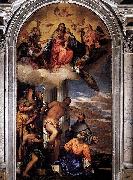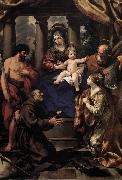
|
BENSON, Ambrosius
|
|||
|
|
|||
| Flemish Northern Renaissance Painter, ca.1495-1550 South Netherlandish painter of Italian birth. In 1518 he acquired Bruges citizenship, and in 1519 he was admitted to the guild of painters and saddlemakers there as an independent master, with the comment that he was 'from Lombardy'. He may have been from Ferrara, although he was originally called Ambrogio Benzone, taking his first name from the patron saint of Milan, the capital of Lombardy. He was probably attracted to Bruges by its commercial and artistic reputation. Initially he worked in the studio of Gerard David, by whom he was profoundly influenced, but after a few months the relationship went wrong and the younger painter brought a case against David. Benson's first marriage was to Anna Ghyselin, who bore him two sons, Willem Benson (1521/2-1574) and Jan Benson (before 1530-before 1581), both of whom became artists. From his second marriage, to Josyne Michiels, a daughter Anna was born, and he had two other daughters from various extra-marital relationships. Benson was an affluent and successful man: he owned several houses, for one of which he gave eight paintings in half payment (which gives some idea of the value of his works at the time). Benson twice received commissions from city magistrates to decorate their new county hall and was a member of the city council on three occasions; he also held important offices within the painters' guild, including dean (1537-8 and 1543-4) and governor (1540-41). His pupils included his two sons, and Joachim Spaers (1541) and Jacob Vinson (Fynson; 1549). | |||
|
|
|||
|
Virgin and Child with Saints BENSON, Ambrosius1.jpg Painting ID:: 5140 |
Wood, 133 x 85 cm Mus??e du Louvre, Paris | ||
|
|
|||
|
Conrad Witz
|
|||
|
|
|||
| 1400-1446 German (Resident in Switzerland) Conrad Witz Gallery -6). German painter. One of the great innovators in northern European painting, he turned away from the lyricism of the preceding generation of German painters. His sturdy, monumental figures give a strong impression of their physical presence, gestures are dignified and the colours strong and simple. Even scenes with several figures are strangely undramatic and static. The surface appearance of materials, especially metals and stone, is intensely observed and recorded with an almost naive precision. Powerful cast shadows help to define the spatial relationships between objects. His fresh approach to the natural world reflects that of the Netherlandish painters: the Master of Fl?malle and the van Eycks. He need not, however, have trained in the Netherlands or in Burgundy as knowledge of their style could have been gained in Basle. He remained, however, untouched by the anecdotal quality present in their art, while Witz pure tempera technique differs emphatically from the refined use of oil glazes that endows Netherlandish pictures with their jewel-like brilliance. | |||
|
|
|||
|
Virgin and Child with Saints new4/Conrad Witz-436482.jpg Painting ID:: 30406 |
mk68 Oil on wood 24 1/2x16" Naples Capodimonte Museum | ||
|
|
|||
|
Conrad Witz
|
|||
|
|
|||
| 1400-1446 German (Resident in Switzerland) Conrad Witz Gallery -6). German painter. One of the great innovators in northern European painting, he turned away from the lyricism of the preceding generation of German painters. His sturdy, monumental figures give a strong impression of their physical presence, gestures are dignified and the colours strong and simple. Even scenes with several figures are strangely undramatic and static. The surface appearance of materials, especially metals and stone, is intensely observed and recorded with an almost naive precision. Powerful cast shadows help to define the spatial relationships between objects. His fresh approach to the natural world reflects that of the Netherlandish painters: the Master of Fl?malle and the van Eycks. He need not, however, have trained in the Netherlands or in Burgundy as knowledge of their style could have been gained in Basle. He remained, however, untouched by the anecdotal quality present in their art, while Witz pure tempera technique differs emphatically from the refined use of oil glazes that endows Netherlandish pictures with their jewel-like brilliance. | |||
|
|
|||
|
Virgin and Child with Saints new4/Conrad Witz-839683.jpg Painting ID:: 30407 |
mk68 Oil on wood 24 1/2x16 Naples | ||
|
|
|||
|
Paolo Veronese
|
|||
|
|
|||
| Italian Mannerist Painter, ca.1528-1588 Italian painter and draughtsman. With Titian and Tintoretto he makes up the triumvirate of great painters of the late Renaissance in Venice. He is known as a supreme colourist and for his illusionistic decorations in both fresco and oil. His large paintings of biblical feasts executed for the refectories of monasteries in Venice and Verona are especially celebrated. He also produced many altarpieces, history and mythological paintings and portraits. His compositional sketches in pen, ink and wash, figure studies in chalk, and chiaroscuro modelli and ricordi form a significant body of drawings. | |||
|
|
|||
|
Virgin and Child with Saints new24/Paolo Veronese-949957.jpg Painting ID:: 81310 |
Date between 1564(1564) and 1565(1565) Medium Oil on canvas Dimensions Height: 420 cm (165.4 in). Width: 230 cm (90.6 in). cjr | ||
|
|
|||
|
Pietro da Cortona
|
|||
|
|
|||
| 1596-1669 Italian Pietro da Cortona Galleries Italian painter, draughtsman and architect. He was, together with Gianlorenzo Bernini and Franceso Borromini, one of the three leading artists of the Roman Baroque. As a painter he developed the early Baroque style, initiated by Annibale Carracci, to a magnificent and imposing High Baroque. His fresco decorations set a standard for European Baroque painting until they were eclipsed by Giambattista Tiepolo's works and those of other Venetian masters of the 18th century. As an architect Cortona was far less influential. His imaginative designs for fa?ades and stucco decorations were, however, conclusive and independent solutions to problems central to Roman Baroque architecture. | |||
|
|
|||
|
Virgin and Child with Saints new26/Pietro da Cortona-643653.jpg Painting ID:: 95768 |
first half of 17th century Medium oil on canvas cyf | ||
|
|
|||
|
Also Buy::. For Following Paintings / Artists / Products, Please Use Our Search Online: |






